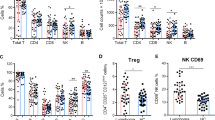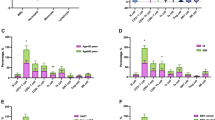Abstract
The use of rituximab brought attention to the hosts’ immune system and to the microenvironment in non-Hodgkin’s lymphoma cases. Our aim was to identify prognostic factors that can be measured easily to indicate the current state of the patient’s immune status and possible reaction against malignant cells. In the retrospective analysis (2000–2008), 66 patients diagnosed with B-cell non-Hodgkin’s lymphomas were enrolled (40 women, 26 men; mean age: 51 years). White blood cells, lymphocytes, CD3 +; CD4 +; CD8 + T-cells, immunoglobulin types A; G; M, anti-cardiolipin antibody isotypes A; G; M; and levels of beta-2-microglobulin were measured before the initiation of the first cycle of chemotherapy, during and after 4-weeks treatment. As for CD 3+ T-lymphocytes, the absolute CD 3+ T –lymphocyte numbers were higher before (0.78 × 109/L) versus during (0.27 × 109/L) treatment, and increased percentages were detected in pre- (66.57 %) and post-treatment (75.32 %). Absolute numbers of CD 8+ T-lymphocyte levels showed reduction before (0.26 × 109/L) versus during (0.10 × 109/L) therapy, but were elevated after (0.28 × 109/L) treatment, while increased percentage before (21.99 %) versus after (29.85 %), and during (24.56 %) versus after (29.85 %) therapy were seen. Average white blood cell numbers were increased before (9.71 × 109/L) versus during (12.07 × 109/L) treatment, while decreased numbers could be observed, after (5.47 × 109/L) treatment. IgA levels were decreased before (2.51 g/L) versus after (1.63 g/L) therapy. IgG levels were higher before (12.25 g/L) vs. after (8.64 g/L) treatment. IgM levels were decreased before (1.76 g/L) and after (0.83 g/L) as well as before (1.76 g/L) versus during (0.73 g/L) treatment. Anti-cardiolipin antibody type A level were decreased before (2.76 U/ml) versus after (2.49 U/ml) treatment. Decreased level of beta-2-microglobulin could be observed before (2.91 mg/L) versus post (2.28 mg/L) chemotherapy. Findings may provide better insight into the effects of immuno-chemotherapy on the hosts’ immune system.
Similar content being viewed by others
References
Jemal A, Siegel R, Xu J, Ward E (2010) Cancer statistics, 2010. CA Cancer J Clin 60(5):277–300. doi:10.3322/caac.20073
Laszlo J, Grizzle J, Jonsson U, Rundles RW (1962) Comparative study of mannitol mustard, cyclophosphamide, and nitrogen mustard in malignant lymphomas. Cancer Chemother Rep 16:247–250
Liu WM, Meyer B, Dalgleish AG (2009) How immunotherapy can enhance the response to other modalities and improve outcome and quality of life. J BUON 14(Suppl 1):S103–S109
Ferrara F, Ravasio R (2008) Cost-effectiveness analysis of the addition of rituximab to CHOP in young patients with good-prognosis diffuse large-B-cell lymphoma. Clin Drug Investig 28(1):55–65
Plosker GL, Figgitt DP (2003) Rituximab: a review of its use in non-Hodgkin’s lymphoma and chronic lymphocytic leukaemia. Drugs 63(8):803–843
Hernberg M (1999) Lymphocyte subsets as prognostic markers for cancer patients receiving immunomodulative therapy. Med Oncol 16(3):145–153
Wahlin BE, Sander B, Christensson B, Ostenstad B, Holte H, Brown PD, Sundstrom C, Kimby E (2012) Entourage: the immune microenvironment following follicular lymphoma. Blood Cancer J 2(1):e52. doi:10.1038/bcj.2011.53
Herreros B, Sanchez-Aguilera A, Piris MA (2008) Lymphoma microenvironment: culprit or innocent? Leukemia 22(1):49–58. doi:10.1038/sj.leu.2404970
Alvaro T, Lejeune M, Escriva P, Pons LE, Bosch R, Jaen J, Lopez C, Salvado MT, de Sanjose S (2009) Appraisal of immune response in lymphoproliferative syndromes: a systematic review. Crit Rev Oncol Hematol 70(2):103–113. doi:10.1016/j.critrevonc.2008.09.013
Alvaro T, de la Cruz-Merino L, Henao-Carrasco F, Villar Rodriguez JL, Vicente Baz D, Codes Manuel de Villena M, Provencio M (2010) Tumor microenvironment and immune effects of antineoplastic therapy in lymphoproliferative syndromes. J Biomed Biotechnol. doi:10.1155/2010/846872
Cheson BD, Pfistner B, Juweid ME, Gascoyne RD, Specht L, Horning SJ, Coiffier B, Fisher RI, Hagenbeek A, Zucca E, Rosen ST, Stroobants S, Lister TA, Hoppe RT, Dreyling M, Tobinai K, Vose JM, Connors JM, Federico M, Diehl V (2007) Revised response criteria for malignant lymphoma. J Clin Oncol 25(5):579–586. doi:10.1200/JCO.2006.09.2403
Bairey O, Blickstein D, Monselise Y, Lahav J, Stark P, Prokocimer M, Nativ HM, Kirgner I, Pazgal I, Shaklai M (2006) Antiphospholipid antibodies may be a new prognostic parameter in aggressive non-Hodgkin’s lymphoma. Eur J Haematol 76(5):384–391. doi:10.1111/j.1600-0609.2005.00620.x
Genvresse I, Luftner D, Spath-Schwalbe E, Buttgereit F (2002) Prevalence and clinical significance of anticardiolipin and anti-beta2-glycoprotein-I antibodies in patients with non-Hodgkin’s lymphoma. Eur J Haematol 68(2):84–90
Talaulikar D, Choudhury A, Shadbolt B, Brown M (2008) Lymphocytopenia as a prognostic marker for diffuse large B cell lymphomas. Leuk Lymphoma 49(5):959–964. doi:10.1080/10428190801959026
Oki Y, Yamamoto K, Kato H, Kuwatsuka Y, Taji H, Kagami Y, Morishima Y (2008) Low absolute lymphocyte count is a poor prognostic marker in patients with diffuse large B-cell lymphoma and suggests patients’ survival benefit from rituximab. Eur J Haematol 81(6):448–453. doi:10.1111/j.1600-0609.2008.01129.x
Porrata LF, Ristow K, Habermann TM, Witzig TE, Inwards DJ, Markovic SN (2009) Absolute lymphocyte count at the time of first relapse predicts survival in patients with diffuse large B-cell lymphoma. Am J Hematol 84(2):93–97. doi:10.1002/ajh.21337
Cox MC, Nofroni I, Ruco L, Amodeo R, Ferrari A, La Verde G, Cardelli P, Montefusco E, Conte E, Monarca B, Aloe-Spiriti MA (2008) Low absolute lymphocyte count is a poor prognostic factor in diffuse-large-B-cell-lymphoma. Leuk Lymphoma 49(9):1745–1751. doi:10.1080/10428190802226425
Gergely L, Vancsa A, Miltenyi Z, Simon Z, Barath S, Illes A (2011) Pretreatment T lymphocyte numbers are contributing to the prognostic significance of absolute lymphocyte numbers in B-cell non-Hodgkins lymphomas. Pathol Oncol Res 17(2):249–255. doi:10.1007/s12253-010-9306-2
Simon Z, Illes A, Miltenyi Z, Magyari F, Varoczy L, Peter N, Gergely L (2012) Immunologic changes in diffuse large B-cell lymphomas after rituximab-CHOP treatment: own data and review of the literature. Orv Hetil 153(42):1658–1666. doi:10.1556/OH.2012.29471
Varoczy L, Gergely L, Miltenyi Z, Aleksza M, Illes A (2005) Can CD3+/HLA-DR+ activated T cells predict the prognosis of non-Hodgkin’s lymphoma patients? Immunol Lett 97(1):155–157. doi:10.1016/j.imlet.2004.10.005
Czuczman MS, Grillo-Lopez AJ, Alkuzweny B, Weaver R, Larocca A, McLaughlin P (2006) Prognostic factors for non-Hodgkin’s lymphoma patients treated with chemotherapy may not predict outcome in patients treated with rituximab. Leuk Lymphoma 47(9):1830–1840. doi:10.1080/10428190600709523
Wahlin BE, Sander B, Christensson B, Kimby E (2007) CD8+ T-cell content in diagnostic lymph nodes measured by flow cytometry is a predictor of survival in follicular lymphoma. Clin Cancer Res 13(2 Pt 1):388–397. doi:10.1158/1078-0432.CCR-06-1734
Yano Y, Ueda Y, Itoh T, Fuji N, Okugawa K, Naito K, Imura K, Kohara J, Hayashi T, Nakane K, Matsuura Y, Kawai K, Yamagishi H (2006) A new strategy using autologous dendritic cells and lymphokine-activated killer cells for cancer immunotherapy: efficient maturation of DCs by co-culture with LAK cells in vitro. Oncol Rep 16(1):147–152
Imura K, Ueda Y, Hayashi T, Itoh T, Shimizu K, Tamai H, Yano Y, Naito K, Kohara J, Nakane K, Matsuura Y, Takeda A, Takeda T, Kawai K, Yamagishi H (2006) Induction of cytotoxic T lymphocytes against human cancer cell lines using dendritic cell-tumor cell hybrids generated by a newly developed electrofusion technique. Int J Oncol 29(3):531–539
Melbye M, Smedby KE, Lehtinen T, Rostgaard K, Glimelius B, Munksgaard L, Schollkopf C, Sundstrom C, Chang ET, Koskela P, Adami HO, Hjalgrim H (2007) Atopy and risk of non-Hodgkin lymphoma. J Natl Cancer Inst 99(2):158–166. doi:10.1093/jnci/djk019
Gergely L, Danko A, Csipo I, Varoczy L, Sipka S, Zeher M, Illes A (2005) Antibodies against extractable nuclear antigen in non-Hodgkin lymphoma patients. Scand J Immunol 61(4):343–346. doi:10.1111/j.1365-3083.2005.01567.x
Acknowledgement
The authors would like to acknowledge Balázs Kotosz Phd. for his help with statistical analysis.
Competing Interests
This is supported by the TAMOP-4.2.2.A-11/1/KONV-2012-0045 project.
Author information
Authors and Affiliations
Corresponding author
Additional information
Éva Pósfai and Gábor Irsai contributed equally to this work and are equal in status.
Rights and permissions
About this article
Cite this article
Pósfai, É., Irsai, G., Illés, Á. et al. Evaluation of Significance of Lymphocyte Subpopulations and Non-specific Serologic Markers in B-cell Non-Hodgkin’s Lymphoma Patients. Pathol. Oncol. Res. 20, 649–654 (2014). https://doi.org/10.1007/s12253-014-9744-3
Received:
Accepted:
Published:
Issue Date:
DOI: https://doi.org/10.1007/s12253-014-9744-3




